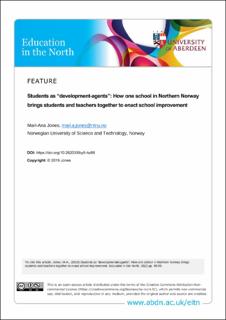| dc.contributor.author | Jones, Mari-Ana | |
| dc.date.accessioned | 2021-01-21T08:35:43Z | |
| dc.date.available | 2021-01-21T08:35:43Z | |
| dc.date.created | 2020-11-18T21:48:42Z | |
| dc.date.issued | 2020 | |
| dc.identifier.issn | 0424-5512 | |
| dc.identifier.uri | https://hdl.handle.net/11250/2724043 | |
| dc.description.abstract | Norway was described in a UNICEF report (Lundy et al., 2012, p. 57) as ‘a pioneer in the field of children’s rights’ and the incorporation of the United Nations Convention on the Rights of the Child (UNCRC) into domestic law in Norway has been identified as a ‘critical point in the development of children’s rights culture’ (ibid, p. 59). The Norwegian National Curriculum requires children to be consulted about their education. Nevertheless, in the annual student survey, around half of Norwegian children report that they are not listened to in schools (Wendelborg et al., 2017, p. 149). Schools are experiencing challenges when putting children’s rights into practice.
This article presents Lakselv High School in remote northern Norway which has prioritised students’ right to be heard. The school community is diverse, representing three communities; Norwegian, Sami and Kvensk (descendants of 18th and 19th century Finnish migrants to Norway). Through the leadership of the Principal, Lakselv has operationalised student voice work, ensuring that it complies with its formal obligations. Furthermore, the school is demonstrating that student voice can impact positively on students’ experience of school, both academic and social; motivating them to complete their high school education. Lakselv offers strategies to combine the perhaps conflicting agendas of student voice and school improvement, indicating that under capable leadership it is possible to harness student voice to develop better schools. | en_US |
| dc.language.iso | eng | en_US |
| dc.rights | Navngivelse-Ikkekommersiell 4.0 Internasjonal | * |
| dc.rights.uri | http://creativecommons.org/licenses/by-nc/4.0/deed.no | * |
| dc.title | ‘Students as “development-agents”: how one school in Northern Norway brings students and teachers together to enact school improvement.’ | en_US |
| dc.type | Peer reviewed | en_US |
| dc.type | Journal article | en_US |
| dc.description.version | publishedVersion | en_US |
| dc.source.volume | 26 | en_US |
| dc.source.journal | Education In The North | en_US |
| dc.source.issue | 2 | en_US |
| dc.identifier.doi | 10.26203/6by5-hz88 | |
| dc.identifier.cristin | 1849567 | |
| dc.description.localcode | This is an open-access article distributed under the terms of the Creative Commons Attribution-Noncommercial License (https://creativecommons.org/licenses/by-nc/4.0/), which permits non-commercial use, distribution, and reproduction in any medium, provided the original author and source are credited. | en_US |
| cristin.ispublished | true | |
| cristin.fulltext | original | |
| cristin.qualitycode | 1 | |

